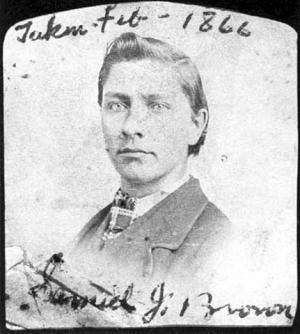 Samuel Brown was the son of Joseph Brown and was an interpreter during treaty negotiations in 1858. He was present during the U.S.-Dakota War of 1862 and reminisced on many of the events, including what happened at Camp Release:
Samuel Brown was the son of Joseph Brown and was an interpreter during treaty negotiations in 1858. He was present during the U.S.-Dakota War of 1862 and reminisced on many of the events, including what happened at Camp Release:
"Weeding out the Guilty: While thus engaged and by exercising a justifiable piece of strategy I assisted in causing the arrest and in safety detaining in custody all the Indian men (except 46 who were above suspicion and three or four who had 'smelled a mice' and ran away during the night), and disarmed them and chained them in pairs together...
"Justifiable Strategy: This successful and justifiable strategy took place at the Government warehouse, built by my father when he was agent a few years before--a large, two-story building, 50 feet long, which the hostiles had burned and destroyed when they passed up on the 20th of August, but the walls of which were still standing--and was accomplished in the following manner: About a hundred yard from this building the soldiers had pitched their tents, while the Indians camped under the hill along Yellow Medicine Creek, a half or three-quarters of a mile distant. I was ordered one day to proceed to the camp and inform the Indians that the annuity roll was to be prepared the next morning and that they must all come at an early hour and present themselves to the agent at the warehouse and be 'counted.' They were delighted to learn that they were at last to get their money. The annuity payment for that year had not yet been made, and this ruse worked like a charm.
"How is was done: About 8 o'clock the next morning the Indians flocked to the warehouse anxious to be 'counted.' Major Galbraith, Captain Whitney, and two or three 'clerks' were found seated at a table behind one end of the building with pens, ink, paper, etc., hard at work on the 'rolls,' while on of the officers and myself were stationed in a doorway at the opposite and further end. As each family would step up to the table, one of the 'clerks' would rise and count or number them with his finger, one, two, three, etc., and after announcing the result with a flourish and motioning for them to pass on, a soldier would step up and escort the Indians to the other end of the building where I was stationed. As they reached the farther end and turned the corner and came in front of the doorway, I would tell the men to step inside and allow the women and children to pass on to the camp, telling them, as I was instructed to do, that the men, as heads of families, must be counted separately, as it was thought the Government would pay them extra. I would take their guns, tomahawks, scalping knives, etc., and throw them into barrels, telling them they would be returned shortly. In this way we succeeded in arresting and safely detaining in custody 234 of Little Crow's fiercest warriors. And since the Indian men outnumbered the soldiers two to one, and were fully well armed, I think that in this case, the end justified the means.'"
 Samuel Brown was the son of Joseph Brown and was an interpreter during treaty negotiations in 1858. He was present during the U.S.-Dakota War of 1862 and reminisced on many of the events, including what happened at Camp Release:
Samuel Brown was the son of Joseph Brown and was an interpreter during treaty negotiations in 1858. He was present during the U.S.-Dakota War of 1862 and reminisced on many of the events, including what happened at Camp Release:



